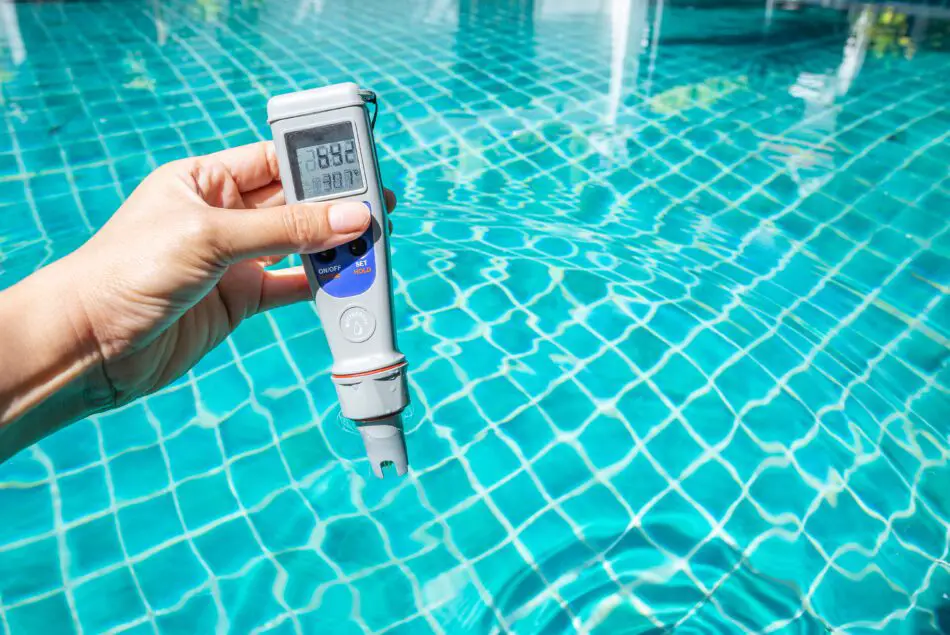
The first chlorine pool was invented and used in the year 1911 by Brown University (See source here). Since then, chlorine pools have become the most popular type of pool in the world. But is it time to rethink that norm?
In most cases, your best bet is to keep cyanuric acid levels between 30 and 50 ppm. Want to learn more about Cyanuric Acid? Read our article Here.
The purpose of Cyanuric Acid in a pool is to protect the free chlorine from the ultraviolet rays from the sun. The two most important factors to consider in terms of balancing your cyanuric acid levels are:
Without any stabilizer, the sun can destroy up to 90% of the chlorine in two hours. The energy contained in UV light from the sun causes the hypochlorous acid and hypochlorite ions formed from the reaction of chlorine and water to break apart in a process called photolysis.
The more direct sunlight your pool receives, the more free chlorine it will lose due to photolysis. One way to combat this is by adding more chlorine more frequently. However, this is both expensive and time consuming. A better approach is to keep your cyanuric acid levels slightly elevated between 60 and 80 ppm. This also means will want to keep your free chlorine levels elevated between 4 and 5 ppm as higher cyanuric acid level reduces chlorine efficacy.
Saltwater pool manufacturers recommend maintaining cyanuric acid levels around 60-80 ppm. This is a bit higher than the 30-50 ppm range recommended for non-saltwater pools. And if you live in an area where your pool gets a lot of direct sunlight, you may even consider bumping your cyanuric acid up to 80-100 ppm.
The reason saltwater pools demand elevated cyanuric acid levels has to do with the output of the salt chlorine generator cells themselves. With a saltwater pool, you are not adding chlorine directly. You add salt which the salt generator processes into chlorine. You may recall that a salt generator creates sodium hypochlorite (bleach). Hypochlorite undergoes photolysis (degradation) from UV light.
Salt Chlorine generator manufacturers prefer to run at a higher level of free chlorine. This is because salt generators create chlorine continuously, so it is important to protect the chlorine that exists.

The first chlorine pool was invented and used in the year 1911 by Brown University (See source here). Since then, chlorine pools have become the most popular type of pool in the world. But is it time to rethink that norm?
Unlike swimming pools, the concern with hot tubs is that cyanuric acid is too high. On one hand, cyanuric acid protects free chlorine from evaporating from exposure to UV light. On the other hand, cyanuric acid slows down the speed at which free chlorine sanitizes water.
This buffering effect is inconsequential in swimming pools. However, hot tubs tend to have a much higher concentration of contaminants because they have a much higher concentration of swimmers – who also perspire more due to the temperature of the water. If cyanuric acid levels get too high, they can render free chlorine ineffective against sanitizing pseudomonas aeruginosa bacteria (hot tub itch).
The most common way hot tubs increase cyanuric acid is by adding stable chlorine to their hot tub (e.g. dichlor or trichlor). These chlorine solutions include stabilizer in them, which means cyanuric acid is added every time chlorine is added. We recommend using a spa-specific chlorine to keep cyanuric acid levels as low as possible – ideally below 30 ppm, especially if your hot tub doesn’t have much exposure to UV light.

Want to learn more about algaecide? Read on to find out when to add algaecide to your pool maintenance routine and other helpful tips.

In this quick guide, we’ll answer the question “can you over shock a pool” and unveil the factors to consider when shocking a pool.

Maintaining both pH and total alkalinity in your swimming pool is important for keeping your pool properly sanitized and non-corrosive. Total alkalinity is to pH what cyanuric acid is to free chlorine. Total alkalinity stabilizes pH levels. The ideal pool pH level is 7.4 to 7.6. The ideal total alkalinity level is 80 to 120 ppm.

The Association of Pool and Spa Professionals recommends free chlorine levels for both swimming pools and hot tubs be kept between 2.0 and 4.0 ppm. However, the Center for Disease Control recommends free chlorine stay above 1 ppm in pools and 3 ppm in hot tubs.